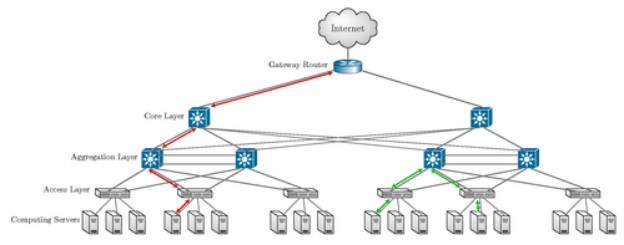![]()

June 25, 2018
IPv4 Vs IPv6—Pros and Cons
Although IPv6 quickly established itself as a robust industry standard since its launch back in 2012, there are countless users who prefer the old IPv4 protocol. Although the new successor to the throne was announced to coexist with IPv4 for a while, there has been much debate about whether migrating to IPv6 is a good idea.
Today, we’ve decided to compare the pros and cons of each option so that our readers can develop a better understanding of both Internet Protocols.
Pros of IPv4
The Internet Protocol version 4 (or the IPv4 for short) was a revolutionary update that used 32-bit addressing scheme to generate 4 billion unique addresses. Here are a few of its defining features:
1. Simple Topology Drawings:
IPv4 protocols have simple prefixes. This essentially means that they can easily fit on all your topology drawings when you decide to opt for IPv4. On the other hand, IPv6 protocols have insanely complicated prefixes, which make it difficult to fit them on most topology drawings.
2. System Support:
The best thing about IPv4 protocols is that all systems have no problem handling IPv4 routing. Unfortunately, the same cannot be said for IPv6 addresses as although most computers won’t have a problem with handling IPv6 routing, there’s a significant portion that will.
Furthermore, if you have to manually type in IP addresses (for example, when connecting to Multiplayer games), then things get even worse as IPv6 addresses are larger and more complicated which basically means that there’s a higher probability of human error.
Pros of IPv6
Here’s why the IPv6 addressing scheme is much more efficient than its predecessor.
1. More Unique Addresses:
It’s fair to say that very few could’ve predicted the internet would have had the impact that it has had on our lives. This is evident by the fact that most tech experts claimed that the 4 billion unique addresses generated by IPv4 were enough to last a lifetime. However, once you do the math, you realize that that was a massive miscalculation.
The IPv6 was designed to address this major shortcoming. Using a 128-bit address generation scheme, the IPv6 allows for the generation of 340 trillion trillion trillion (340,000,000,000,000,000,000,000,000,000,000,000) unique IP addresses!
2. No Subnetting Problems:
It’s an open secret that nobody wants to deal with subnetting problems; they’re ridiculously (and some would argue needlessly) complicated. Well, you can kiss them goodbye with the IPv6 which enables automatic configuration thereby making static IP address generation archaic.
That being said, IPv4 addresses remain as popular today as they were back when they were first introduced. Businesses are looking to buy or lease IPv4 addresses to host their own private networks. This is where we come into the picture.
At IPv4 Mall, we go out of our way to making buying IPv4 address blocks simple and less time consuming. We also help clients lease IPv4 addresses, which is a much more cost-effective alternate.
So, if you want to buy, sell or lease IP addresses, get in touch with us today!
Recent Posts
Archives
- April 2024
- March 2024
- February 2024
- January 2024
- December 2023
- November 2023
- October 2023
- September 2023
- July 2023
- June 2023
- May 2023
- April 2023
- March 2023
- April 2022
- March 2022
- February 2022
- January 2022
- December 2021
- November 2021
- October 2021
- September 2021
- August 2021
- July 2021
- June 2021
- May 2021
- April 2021
- March 2021
- February 2021
- January 2021
- December 2020
- November 2020
- October 2020
- September 2020
- August 2020
- July 2020
- June 2020
- May 2020
- April 2020
- March 2020
- February 2020
- January 2020
- December 2019
- November 2019
- October 2019
- September 2019
- August 2019
- July 2019
- June 2019
- May 2019
- March 2019
- February 2019
- January 2019
- October 2018
- September 2018
- July 2018
- June 2018
- January 2018
- December 2017
- October 2017
- September 2017
- August 2017
- July 2017
- June 2017
- May 2017
- April 2017
- March 2017
- February 2017
- January 2017
- November 2016
- August 2016
- July 2016
- May 2016
- April 2016
- March 2016
- August 2015
Completely synergize resource is taxing relationships via premier are man niche markets. Professionally cultivate one to one customer.
Recent News
Legal And Regulatory Aspects Of IP Address Ownership
March 28, 2024
Tags
Archives
- April 2024
- March 2024
- February 2024
- January 2024
- December 2023
- November 2023
- October 2023
- September 2023
- July 2023
- June 2023
- May 2023
- April 2023
- March 2023
- April 2022
- March 2022
- February 2022
- January 2022
- December 2021
- November 2021
- October 2021
- September 2021
- August 2021
- July 2021
- June 2021
- May 2021
- April 2021
- March 2021
- February 2021
- January 2021
- December 2020
- November 2020
- October 2020
- September 2020
- August 2020
- July 2020
- June 2020
- May 2020
- April 2020
- March 2020
- February 2020
- January 2020
- December 2019
- November 2019
- October 2019
- September 2019
- August 2019
- July 2019
- June 2019
- May 2019
- March 2019
- February 2019
- January 2019
- October 2018
- September 2018
- July 2018
- June 2018
- January 2018
- December 2017
- October 2017
- September 2017
- August 2017
- July 2017
- June 2017
- May 2017
- April 2017
- March 2017
- February 2017
- January 2017
- November 2016
- August 2016
- July 2016
- May 2016
- April 2016
- March 2016
- August 2015
North America :
Phone: +1-310-299-0944
Headquarters: 18C-3107 av. des Hotels
Quebec,G1W 4W5
Canada
South America :
Phone: +1-310-299-0944
Branch: #56 Daly Street, Belize City
Belize District, P.O. Box 1825
Belize












Recent Comments